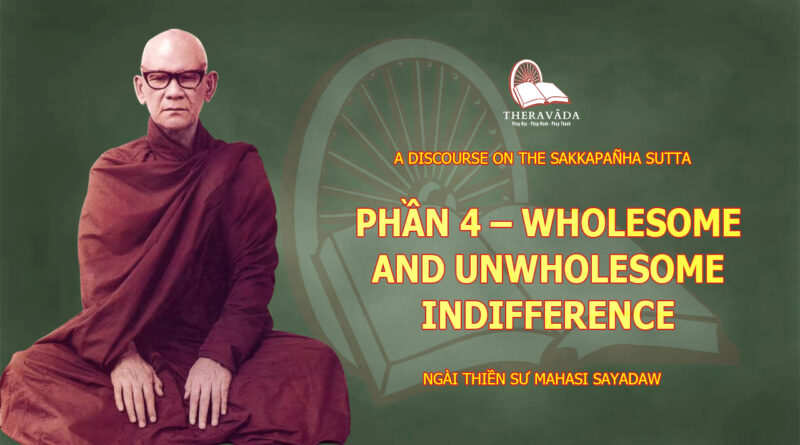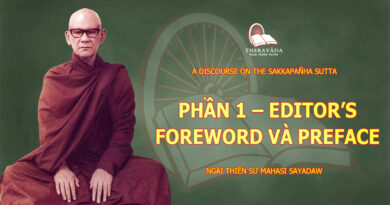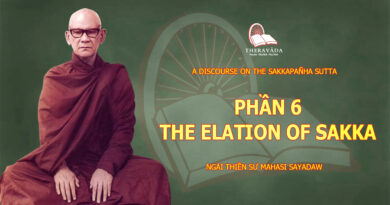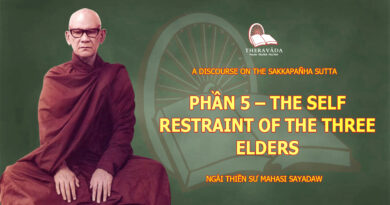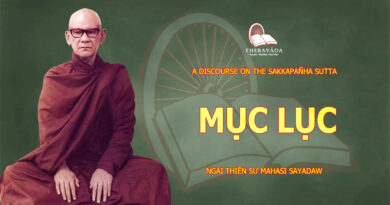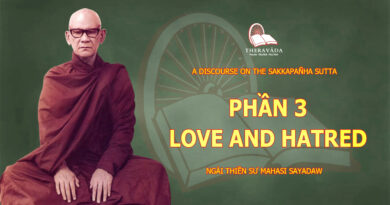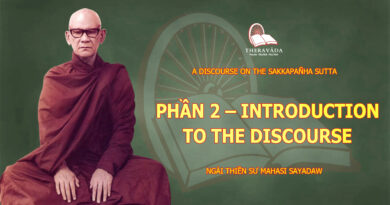Nội Dung Chính
Phần 4 – Wholesome and Unwholesome Indifference
Wholesome and Unwholesome Indifference
– The Rebirth of Sakka
– The Virtue of Monastic Restraint
– The Virtue of Sense-faculty Restraint
– The Story of Mahātissa Thera
– The Story of Cittagutta Thera
Wholesome and Unwholesome Indifference
Upekkhā means indifferent feeling, which is neither joy nor sorrow. It arises more often than the other feelings, joy and sorrow being occasional states of consciousness, but it is apparent only when concentration is powerful. Again, indifference is of two kinds: wholesome indifference that leads to good deeds and unwholesome indifference that leads to bad deeds. The Saḷāyatanavibhaṅga Sutta mentions six types of indifference that arise from the six senses.
The unwholesome indifference that arises from the senses in ignorant and confused persons, is called gehasita-upekkhā. We feel joy at the sight of a pleasant object and sorrow at the sight of an unpleasant object, but we have indifferent feelings, which are neither good nor bad, when we see very familiar people or objects. For example, we feel neither pleasure nor displeasure when we see a tree or a stone.
Unwholesome indifference is found among common people (puthujjana), unlike Ariyas or even refined people (kalyāṇa puthujjana), who are aware of impermanence, etc. This state of consciousness arises in ignorant commoners, and here we mean those ignorant people who do not know the real nature of sense-objects, because of their lack of mindfulness. As a result they remain unaware of impermanence and are wedded to the illusion that all phenomena are permanent and good.
The Commentary gives further details about the ignorant person who is subject to unwholesome indifference. He is not an Ariya at the Stream-winner stage (sotāpanna), which marks the conquest of the defilements that lead to the lower worlds; or at the Once-returner stage (sakadāgāmi), which ensures freedom from gross sensual desire and ill-will; or at the Non-returner stage (anāgāmi), which means the total elimination of these two defilements. Not having done away with any one of the defilements, the commoner who suffers from unwholesome indifference is not one of these three types of Ariya.
He is also not a person who has neutralised the effect of kamma. It is only the Arahant who can overcome kammic effects such as rebirth-consciousness, etc. These two negative attributes, namely, being still prone to defilements and being still subject to the law of kamma, show that unwholesome indifference arises only in non-ariyan puthujjana. By puthujjana the Commentary means the ordinary person who is devoid of insight and knowledge.
He is described as a person who does not see the evils of delusion (moha). Owing to his lack of mindfulness he does not understand the truth, believing instead in the illusion of a permanent ego. This illusion leads him to pleasurable desire, to attachment and to the effort for self-fulfilment. This effort in turn gives rise to good or bad kamma, resulting in rebirth, which brings old age, sickness, death and all other sufferings.
The ordinary person does not see these evils of illusion nor does he have knowledge. Knowledge is of two kinds: knowledge of the Buddha’s teaching through hearing discourses, etc., and empirical knowledge gained through meditation and insight on the path. Both kinds of knowledge are foreign to him, so he has the indifference that is born out of illusion. The sense-objects cause neither joy nor pain in him but he nevertheless remains steeped in the world of the senses. Hence the term gehasita-upekkhā is used where geha means the house of the senses. In other words, the ordinary person does not outgrow the phenomenal or the sensual world, and so remains blind to its real nature: its impermanence and other characteristics.
The Commentary on the Sakkapañha Sutta explains wholesome indifference at length on the basis of what is said in the Saḷāyatanavibhaṅga Sutta. Wholesome indifference, or renunciation-oriented indifference, is called nekkhammasita-upekkhā and is of six kinds, depending on the six senses. The meditator who is mindful of the passing away of all sense-objects realises that every phenomenon is subject to impermanence, suffering and dissolution. This insight into the reality of the universe leads him to a feeling of equanimity, which helps him to outgrow the sensual world and to free himself from attachments. He is then indifferent to both pleasant and unpleasant sense-objects.
For the meditator who is mindful and has developed concentration, everything arises only to pass away instantly. The discourses usually stress this fact with reference to visual objects in the first place, but in practice it is initially apparent with regard to the objects of contact and thought. If any thought arises while being attentive to the rising and falling of the abdomen, it vanishes the instant the mind is fixed on it. With the development of concentration the meditator becomes aware of the arising and passing away separately, and later on awareness extends to the repeated disappearance of each of them. At this stage of the knowledge of dissolution (bhaṅga-ñāṇa) he sees the abdomen, hands, etc., not as solid things but as phenomena that vanish ceaselessly and instantaneously.
The ceaseless dissolution of phenomena becomes more apparent with the development of the knowledge of dissolution so that the meditator finally realises the law of impermanence. Knowing thus the nature of mind and matter as it really is, he feels neither joy nor sorrow, but simply remains aware of the sense-objects. This fleeting awareness leads to a feeling of indifference, which is more predominant when knowledge of dissolution and knowledge of equanimity about formations (saṅkhārupekkhā-ñāṇa) illuminate the mind.
At these stages on the path the meditator is neither pleased nor displeased with the sight of pleasant or unpleasant objects. He is above attachments with regard to sights, sounds, etc., and his indifference is beyond the sensual world. In fact this is the goal of insight meditation practice, which is freedom.
The meditator should seek this wholesome, insight-oriented equanimity. It is first experienced at the advanced stage of rising and passing away, and is most pronounced at the stage of equanimity about formations. According to the discourse, it is of two kinds, namely equanimity with discursive thinking and equanimity without such thinking. In reality all equanimity that occurs during contemplation involves discursive thinking. However, the equanimity that arises while watching the sensual and first jhānic consciousness is called equanimity with discursive thinking, whilst that which occurs while absorbed in the second jhānic state is called equanimity without discursive thinking. Of the two kinds of equanimity, the one without discursive thinking is superior.
The Rebirth of Sakka
The main aim of insight meditation is to seek and cultivate the equanimity that is associated with the knowledge of equanimity with regard to formations. To this end we should avoid sensuous joy, and should seek wholesome joy in good deeds and contemplation. Likewise we should welcome wholesome sorrow arising from the frustration of our efforts on the holy path, and we should avoid unwholesome sorrow. Similarly, we should avoid the unwholesome equanimity of the sensual world and seek the wholesome equanimity of the holy path.
Here the emphasis is on the positive aspect of the practice. In other words, we should concentrate on wholesome joy, wholesome sorrow and wholesome equanimity, because the cultivation of these wholesome states of consciousness means the elimination of their negative, i.e. unwholesome, counterparts.
We should also eliminate wholesome sorrow through wholesome joy. This means that if we are depressed because of our failure to make much progress on the holy path, we must overcome this depression by exerting more effort to attain insight. Likewise, wholesome joy must be rejected through wholesome equanimity, as this wholesome equanimity through insight is the pinnacle of the holy life. However, the joy attained in insight meditation is not to be wholly rejected because this joy forms the basis for the first three jhānic paths and their fruitions. Moreover, the meditator who does not attain jhāna cannot attain the fourth jhānic path, which is the path with equanimity. He can attain only the first three jhānas with joy. He usually attains the path and its fruition through the stage of adaptation knowledge (anuloma-ñāṇa) with joy. Hence the Buddha’s emphasis on vipassanā upekkhā as the highest state of consciousness.
Thus knowledge of equanimity about formations is only one step removed from the holy path and its fruition. If the meditator does not become complacent with this insight, he usually attains the path in four or five days. So equanimity with renunciation-joy should be sought since it is conducive to the holy life at the level of the path of insight.
A meditator should subordinate wholesome sorrow to wholesome joy, and even wholesome joy to wholesome equanimity, until attaining the knowledge of equanimity with regard to formations. This means the attainment of the four stages of the holy path, and the extinction of desire, conceit and wrong-view. Summarising this, the Buddha said to Sakka, “O King of devas! The bhikkhu who avoids unwholesome dhammas and seeks wholesome dhammas is committed to the middle way of the good life that leads to nibbāna, the extinction of all defilements.”
While following the Buddha’s discourse, Sakka contemplated his states of consciousness, cultivated wholesome joy and wholesome equanimity, developed insight knowledge and became a sotāpanna. This was followed by his demise and rebirth as a new Sakka. He attained only the first stage of the holy path as his spiritual potential was limited.
The rebirth of Sakka shows that a dying deva can benefit by hearing the Dhamma. Through mindfulness of wholesome emotions the meditator can make good progress on the holy path, and the most common of these emotions is wholesome joy. In Sri Lanka, Venerable Phussadeva became an Arahant after contemplating the joy that arose in him at the sight of the Buddha image. The queen of King Asoka also attained the Stream-winner stage after contemplating the joy that welled up in her when she heard a bird, whose singing sounded like the voice of the Buddha. According to the Commentaries, the meditator may even attain Arahantship while contemplating wholesome joy, or he may attain the holy path and its fruition through the contemplation of generosity or morality, and the impermanence of the wholesome joy that results from his recollection of them.
Having attained the first stage, Sakka became wholly free from doubt and the illusion of an ego-entity. The freedom that he now enjoyed was superior to any that he had experienced in the past, in that it was the freedom of a Stream-winner, whereas formerly his freedom had been based on knowledge and thinking.
The Virtue of Monastic Restraint
Sakka asked the Buddha about the relationship between morality and the holy life. “Venerable sir, what is the moral practice that protects one from the lower worlds or from unwholesome deeds, words or thoughts?”
The Buddha said that there are two kinds of deeds: wholesome deeds and unwholesome deeds. He classified speech and livelihood in the same way. Any action, speech or means of livelihood that contributes to good kamma is wholesome, and any that contributes to bad kamma is unwholesome. Unwholesome actions are killing, stealing and indulging in sexual misconduct. Abstinence from these actions constitutes wholesome action. These are the precepts for lay disciples, but there are many more precepts that the bhikkhus have to observe in accordance with the teachings of the Vinaya Piṭaka.
Lies, slander, abuse, and idle, frivolous talk are unwholesome verbal actions, whereas abstaining from such unwholesome speech is wholesome verbal action. To make one’s living through unwholesome actions or unwholesome speech is likewise unwholesome livelihood. Conversely, wholesome livelihood is that which has nothing to do with such action or speech. It follows that, for the layman, the observance of the five precepts ensures moral purity.
Some people may say that the precepts refer only to lying and do not explicitly enjoin abstinence from the other kinds of wrong speech and wrong livelihood. However, abstinence from lying implies abstinence from the other kinds of unwholesome speech since all of these evils involve false assertions. Likewise, we avoid wrong livelihood if we avoid killing, stealing, sexual misconduct and selling intoxicants, since keeping the five precepts entails avoiding these immoral actions, whether it is to earn one’s living or for any other reason. So the five precepts constitute the basic moral restraint for the laity.
The Virtue of Sense-faculty Restraint
Then Sakka asked the Buddha how a bhikkhu should practise sense-restraint (indriyasaṃvara-sīla). Indriya means to govern or control, and here it refers to the six governing sense-organs, namely the eye, the ear, the nose, the tongue, the body and the mind. These six govern seeing, hearing, smelling, tasting, touching and consciousness respectively. Sakka asked the Buddha how one should guard these senses.
The Buddha made a distinction between two kinds of sense-objects: those that should be accepted and those that should be rejected. One should accept the sense-objects that discourage bad kamma and encourage good kamma; and one should ignore those that discourage good kamma and encourage bad kamma. We should avoid looking at objects that cause pleasure, anger, etc. If they are unavoidable, we ought to stop thinking and practise some kind of contemplation; or we should make a note of seeing, and stop short of letting the mind wander beyond bare awareness. This is the way to reject unwholesome sense-objects.
Similarly, we should not pay attention to unwholesome kamma. On the other hand we should listen to the recitation of the Dhamma, as it is obviously the mainspring of good kamma. Whatever the sound may be, if we focus on hearing and note its qualities of impermanence, etc., this will contribute to the development of insight.
The enjoyment of the sense of smell usually causes bad kamma. On rare occasions it induces good kamma as, for instance, when we note the fragrance of flowers offered at the shrine, with reference to the three characteristics. The same may be said of tastes, but since we cannot live without food, we can avoid bad kamma only by eating mindfully. It is also good for us if we can avoid very delicious food, and of course, we should always avoid any food or drink that is intoxicating. Although we may eat good food, we can avoid defilement if we do not crave for or care about its delicacy. This degree of restraint is impossible for unmindful persons.
Bodily contact also usually leads to unwholesome kamma. It is not possible to avoid all touching, but we should avoid, as far as possible, sexual contact, which causes pleasure and attachment. We should restrain the senses so that we can detach ourselves, and thus disregard delightful or painful sensations. The best way to gain total restraint is, as mentioned before, to note the impermanence, etc., of all tactile sensations. Good kamma arises through mindfulness of all tactile impressions in accordance with the Satipaṭṭhāna Sutta. Discriminative and discursive thinking about men, women, enemies, and so on, is to be avoided since it leads to passion, ill-will and the other defilements. Should such thoughts occur, they must be replaced with meditation on the Buddha, one’s morality, etc., and their arising and passing away should be noted.
There are many other discourses that contain the Buddha’s teaching about the restraint of the senses. Typical of these teachings is the following advice: “When you see a man or a woman you should not think of his or her physical features. You should avoid noticing the eyes, eyebrows and other particular features of the body as this will surely give rise to defilements.” Men should not think of a woman’s physical features as a whole, or the particular features such as hair, mouth, bosom and so forth, and likewise, women should avoid thinking of those of a man, for such thinking fuels the passions. The meditator must give bare attention to seeing and avoid thinking about the physical form as a whole or about the different parts of the body.
The Buddha pointed out the evils arising from lack of sense-restraint: “One who does not guard his eyes is forever beset with craving and ill-will”, but this restraint must be exercised in the proper way. The meditator must avoid looking at familiar objects (pleasant or unpleasant) that arouse unwholesome thoughts. If he sees them by chance he should pay no attention to their form, colour, etc., and should retain no impression of them. He simply keeps himself aware of what he is seeing and bears in mind its impermanence, etc.
The same may be said of the other senses: hearing, smelling, tasting, touching and thinking. With the development of concentration, the meditator can focus on all psycho-physical phenomena and realise their characteristics of impermanence, unsatisfactoriness and not-self, thereby leaving little room for the emergence of defilements. This is the best way to restrain the senses, and through such sense-restraint the meditator can attain the holy path and its fruition, after passing through the successive stages of insight. The attainment of Arahantship in this way is mentioned in the following story of Mahātissa thera from the Visuddhimagga.
The Story of Mahātissa Thera
While Mahātissa thera was on the way to Anurādhapura to collect alms, he met a woman. Having quarrelled with her husband, she had set out for her parents’ home. She was well dressed and at the sight of the elder she laughed seductively. Formerly the elder had often reflected on the impurity of the human body, and so, on looking at the woman, he had a vision of a loathsome skeleton. Consequently he attained the first jhāna, and through insight meditation, became an Arahant. The husband, having followed the woman, met the elder and asked him whether he had seen a woman. The elder replied that he had seen only a skeleton that had gone along the road.
The elder must have practised contemplation on the impurity of the body for a long time. His experience is a lesson for meditators who are disheartened by their lack of progress, for they will attain insight in due course if they keep on trying.
The Story of Cittagutta Thera
The restraint of the senses as practised by another elder is also cited in the Visuddhimagga.
Cittagutta thera dwelt in a cave in Sri Lanka, high up on the walls of which were frescoes of the Buddha’s birth stories (Jātaka). Since he practised constant sense-restraint, the elder never looked up, and so he remained quite unaware of these frescoes.
One day some young monks came to the cave. They were fascinated by the pictures and remarked on their beauty to the elder, but he replied that he had never noticed them, although he had lived in the cave for over sixty years. His response was an indirect rebuke to the visitors for their lack of mindfulness with respect to their eyes.
There was also a Gangaw tree near the entrance of the cave. The elder had never looked up at it and so he knew that the flowers were in full bloom only when he saw the petals lying on the ground. Hearing about the elder’s holiness, the king invited him to the palace, but, in spite of repeated invitations, the elder refused to visit the king. As a consequence, the king forbade the suckling of infants by their mothers in the village where the elder went about to collect alms in the morning. So, out of compassion for the babies, the elder finally went to the palace. The king and the queen paid respects to the elder and he blessed them one after another saying, “May the king be happy!” When the young monks asked him why he always said “May the king be happy!”, whether he addressed the king or the queen, the elder replied that he did not notice whether it was the king or the queen. This is a lesson for those who practise sense-restraint.
The most important thing is to avoid those sights that give rise to defilements, and if they are unavoidable, to contemplate their impurities or to make a note simply of seeing. Here we should bear in mind the Buddha’s reply to Venerable Ānanda, on the eve of his parinibbāna, when he asked how a bhikkhu should behave regarding women. The Buddha said that a bhikkhu should avoid seeing women, and if he cannot avoid seeing them, he should not speak to them. If he cannot avoid speaking to them, then he should be mindful, and regard the woman either as his mother, sister or daughter, according to her age.
This is the first practice suggested in the Bhāradvāja Sutta of the Saṃyuttanikāya for overcoming sensual desire. The second practice mentioned is the reflection on the impurity of the human body. The third practice is the restraint of the senses.
The Buddha’s teaching applies to other sense-objects as well. We should avoid listening to sounds such as songs, etc., which arouse the defilements. If we cannot avoid them, we must make a note simply of hearing. The need for such mindfulness is obvious in the case of monks and meditators, but the Buddha’s teaching was addressed to Sakka and to the other devas. Devas are usually engrossed in sensual pleasures and so it is necessary for them to restrain their senses as far as possible. The same may be said of lay disciples when they observe the Sabbath or practise meditation.
The scents of flowers, perfumes, etc., that cause defilements to arise should be treated in the same way. So should the food that the meditator eats only after due reflection (that he eats not for pleasure but to preserve his health). Sensations of taste and touch that lead to defilements are also to be avoided, and if unavoidable, they should be dealt with in the same way. Making a note of walking, sitting, etc., constitutes mindfulness of tactile sensations.
According to the Commentary, the practice of Nissajji dhutaṅga is a wholesome pursuit in relation to the sensation of touch. Nissajji dhutaṅga is the ascetic practice of never lying down but remaining always in the sitting position, even when asleep, which some meditators do. Venerable Sāriputta, Venerable Mahākassapa and other prominent disciples of the Buddha practised it for long periods, ranging from twelve years in the case of Venerable Rāhula to a hundred and twenty years in the case of Venerable Mahākassapa. Since they were Arahants their object was not to acquire merit but to serve as examples for posterity.
The meditator should patiently make a note of wholesome sensations of touch while practising insight meditation, keeping himself mindful of wholesome sense-objects. When he feels unpleasant sensations in the body he should not fidget, but should exercise patience as far as possible, and keep on contemplating those sensations in accordance with the teachings of the Sakkapañha Sutta.
Moreover, the meditator should not think of anything that can give rise to craving or ill-will; he must refrain from doing so, not only with respect to the mental-objects or thoughts that occur to him at present, but also with regard to those belonging to the past and the future as well. They should be noted and rejected.

